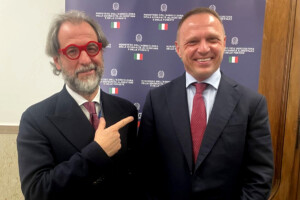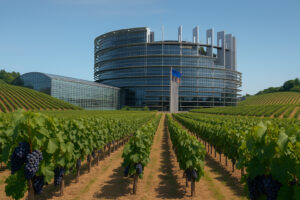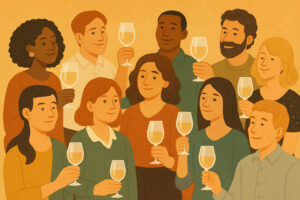Memories. Enough to write not a book, but an encyclopedia, or even a historical atlas, of Italian wine, capable of retracing, between a memory and another, the last half-century of Italy's wine. A journey made of stumbles, challenges, difficulties, but also many achievements. And who better than Angelo Gaja, the volcanic dean of wine in Italy and symbol of the “great Piedmont”, could “afford” such a story? And a story is exactly what was staged at the “Milano Wine Week”, which starts from afar, since “Italian wines in the U.S. were priced below the minimum price of the French”. It was the sixties, and thinking of competing with Bordeaux, Champagne and Burgundy seemed an impossible task. Fortunately, this is no longer the case today, “and yet in terms of average price we are behind New Zealand and the USA itself. Now the social wineries have to make a leap forward in terms of enhancement, because it is thanks to them that we gain market share, but we cannot be satisfied with these prices. There are virtuous examples - remembers Gaja - like that of the Barbaresco Producers, but they must be followed”.
It was the years, between 1966 and 1967, when the Ais (the “Sommeliers”, ed) was born, “which had a key role in the training, first of the restaurateurs and then of the producers. And it is in the top restaurants around the world that a brand is consolidated, because Gaja, today, has its own page in the wine list of 2,000 restaurants, and this is the best business card that a company can have”, says Gaja. A principle that applies to everyone, and that has accompanied the success of dozens of great labels in the Belpaese, on which has undoubtedly had a fundamental impact the international critics, able with its judgments and scores to sanction the fortunes of a wine. “And yet - says Gaja - this does not in any way reduce the value and work of the many Italian critics, who I am sure are also inspirational to American wine writers. People like Robert Parker, however, have had the ability to launch a message in a universal language on a market of 300 million people”.
And it was from the Anglo-Saxon world, first of all, the coronation of wines such as “Sassicaia, Masseto, Ornellaia, Tignanello and Solaia, or rather the super Tuscan wines, born as table wines and then becoming IGT or DOC, in some cases, thanks to which Tuscany has overcome the crisis of Chianti, imposing new enological models, based on international grape varieties such as Cabernet Sauvignon and Merlot: a response to those who argue that in Italy we should work only on native varieties, without understanding the real demands and needs of the market that instead increasingly rewards this type of wine. Behind which - continues Gaja - there was almost always the hand of a great enologist like Giacomo Tachis, who knew the wine like no other”.
This is how the door opens, starting from Tachis, to a universe of points of reference that starts with the founder of Slow Food, Carlo Petrini, capable of “restoring dignity to food and peasant work. A healthy competition between small artisan producers was born for everyone: on the impetus of Slow Food and its guide to wines, many grape sellers have chosen to produce following the example of others. In Piedmont, success is linked to the artisans, who produce 20-25% of the wine, compared to 20% of the wineries, a sort of security quota”. And then there is Bruno Giacosa, a fundamental producer of Barolo, “the best at understanding what his wine would be like just by tasting the grapes: he knew the vineyards like his pockets, he had an extraordinary eye, and he always tasted a few grapes two or three weeks before harvesting”. Another great example, remaining in Piedmont, was that of “Aldo Conterno. In 2008 the crisis began, which also involved the world of wine, the market in the early months of 2009 was static, importers did not send orders, but Conterno was positive, he said that, with Barolo and Barbaresco, we would resist, and that consumers would return, willing to pay even more than before, and that's exactly how it went”. Without forgetting “a great artisan like Bartolo Mascarello, who was not afraid to contradict himself: he hated marketing, but made the biggest marketing choice in the history of Barolo with his legendary label, the 1999 vintage of Barolo “No Barrique, no Berlusconi””.
Finally, another leap forward, to the present day, in which the main theme of the public debate concerns climate change and its protagonists, namely “Donald Trump, a smart subject, who has been able to make money, who in a Presidential Republic puts the U.S. before everyone: but the others? He is on exaggerated positions, especially in the media, starting from the fact that he has parted from the Paris agreement”, and Greta Thumberg, “also has a media impact, but I prefer his positions, she has been able to sensitize a generation to a gigantic problem. Which concerns wine in the first place. Spain, like France, is warming up by many degrees in the center of the country, both will need to find different solutions in viticulture, focusing on resistant varieties and different rootstocks. Especially France, which has a wine-growing heritage rich in early varieties, from Merlot to Sauvignon, but also the ability and the possibility - says Angelo Gaja - to do research at a high level. Italy, on the other hand, could have fewer problems, thanks to the mitigating effect of the sea and the protection guaranteed by the Alps”.
Copyright © 2000/2025
Contatti: info@winenews.it
Seguici anche su Twitter: @WineNewsIt
Seguici anche su Facebook: @winenewsit
Questo articolo è tratto dall'archivio di WineNews - Tutti i diritti riservati - Copyright © 2000/2025









































































































































































































